by: J.B. Wood | Contributing Editor
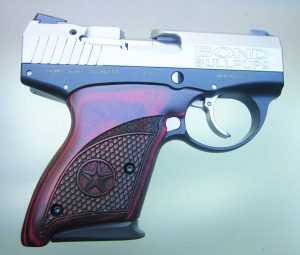
The Bond Bullpup, right side
A few years ago, Arne Boberg had an excellent idea. He designed a tiny, sub-compact 9mm pistol that was very different. The rifled portion of the barrel measured almost 3 inches, allowing a 9mm bullet to attain its full velocity. And yet, the barrel did not protrude. How did he do this?
He moved everything back, extending the barrel over the magazine well, and changed the feed direction to the rear. From about 2012 to 2016, Arne produced the pistol himself as the Boberg XR9-S. Then, he sold the tooling and manufacturing rights to Bond Arms. Because the action was moved rearward, they named it the Bond Bullpup.
In addition to its rearward-feeding, the magazine is also different in another way. There is no follower on top of the spring. Instead, the top of the spring is formed for a slick contact with the cartridge case. It may look weird to you “old hands,” but it works fine.
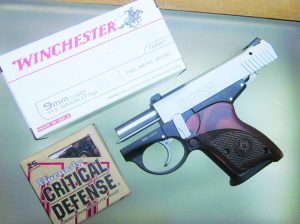
The Bullpup with the test ammo. The takedown latch can be used as a slide hold-open.
So, how does the rear-feeding function? It’s not complicated. On the underside of the slide, there’s a tilting part with a set of “tongs” at the front. They firmly grip the case rim, and pull the cartridge out of the magazine. As the slide reaches full rear, it strikes the lug of a pivoting platform in the frame, lifting the round away from the “tongs” to engage the extractor.
In this position, the cartridge is perfectly aligned with the chamber. It doesn’t have to climb a feed-ramp. And, this brings us to another good feature. The locking system is not falling-barrel, it’s turn-barrel. This puts the bore axis closer to the hand, reducing muzzle-flip. Also, there is another height-affecting thing. The recoil spring is not below the barrel, it’s almost beside it, on the left side.
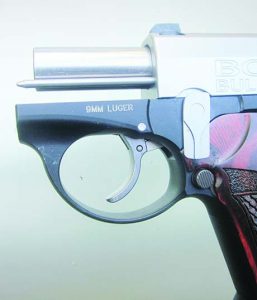
Set at its half-way point (vertical), the takedown latch will hold the slide open.
The firing system is a true Double-Action-Only (DAO), with a pivoting hammer at the rear. The trigger is wide, with a smooth surface, and no silly “flipper” safety. With the long DAO trigger pull, there is no need for a manual safety. Internally, an automatic firing-pin-block safety is always “on-safe” until the last bit of trigger pull.
The push-button magazine release is in the usual location, at the rear terminus of the trigger guard. Left-handers note: it is reversible. The only other external control is the takedown lever. It can be set at its half-way mark (vertical) to hold the slide open for a quick brush-out. With the rear-feed no-follower magazine, there’s no last-shot hold-open.
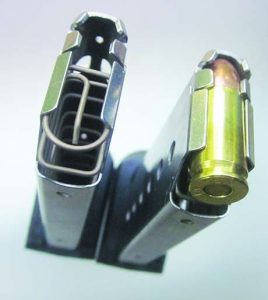
The magazines, one with a round in place, the other showing the formed spring.
In a sub-compact, sights are less important, but these are very good. Square-picture, three white dots, with a nice wide notch in the rear. Both are in dove-tails, secured by hex-head screws, and they’re made of steel. After loosening the screw, the rear one can be adjusted laterally. If you’re moving it, be sure it stays in the dovetail. Its underside retains the spring and plunger for the firing-pin-block.
This brings to mind another caution, regarding ammo. Avoid cheap stuff, reloads, aluminum cases, or anything else that does not have a firm crimp-hold on the bullet. With any of those, that sharp yank of the “tongs” can pull the case right off, causing a spectacular jam. With the right ammo, this will never happen.
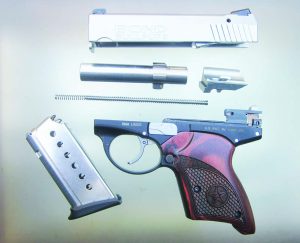
The Bond Bullpup, field-stripped.
In the good instruction manual, there’s a long list of approved range loads, and a shorter one for serious business. For test-firing, the recommended loads that I used were Winchester “White Box” 115-grain FMJ, and Hornady Critical Defense. Shooting was standing, two-hand hold, at 7 and 15 yards.
All groups were well-centered, and the average was 4 to 5 inches. The felt-recoil was surprisingly mild, considering the Bullpup weighs only 18.7 ounces. The other numbers: Length, 5 inches; Height, 4.06 inches; Width, 1 inch; Barrel, 3.18 inches, and Magazine capacity, 7 rounds.
Aside from the mechanical applications, the moderate felt-recoil can also be traced to the superior ergonomics of the grip-frame. At the lower rear of the trigger-guard, a concave area allows more finger-space on the front-strap. At the rear, the nice laminated-wood grips meet to form the backstrap, and at the top there is a deep in-curve. These features set the Bullpup solidly in the hand.
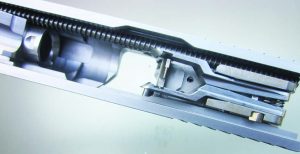
Inside the slide, the lever with “tongs” that pulls the cartridges out rearward.
The silky smoothness of the trigger pull, average about 8 pounds, is another example of good design. The system uses a push-bar, not a draw-bar, to act on the hammer. And the hammer spring is an expansion-type, not compression. Bond’s beautiful machine-work on all of the components also helps.
On my test pistol, the high-tech alloy frame is finished in matte black. All of the other parts are matte or polished stainless-steel. I think it’s likely that other finishes may be offered later, including an all-black version. Considering the precision and the performance, the suggested retail price of $977 seems quite reasonable.
If you have any other questions, here’s the contact data: Bond Arms, Inc., P0 Box 1296, Granbury, TX 76048. Phone: 817-573-4445; online: bondarms.com. If you want full performance of all 9mm ammo in a sub-compact pistol, the Bond Bullpup is the answer.



